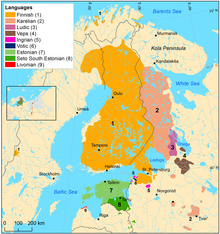
Baltic Finnic peoples
Group of peoples around the Baltic Sea / From Wikipedia, the free encyclopedia
Dear Wikiwand AI, let's keep it short by simply answering these key questions:
Can you list the top facts and stats about Baltic Finns?
Summarize this article for a 10 year old
The Baltic Finnic peoples, often simply referred to as the Finnic peoples,[lower-alpha 1] are the peoples inhabiting the Baltic Sea region in Northern and Eastern Europe who speak Finnic languages. They include the Finns, Estonians (including Võros and Setos), Karelians (including Ludes and Livvi), Veps, Izhorians, Votes, and Livonians. In some cases the Kvens, Ingrians, Tornedalians and speakers of Meänkieli are considered separate from the Finns.
 Finnic languages at the beginning of the 20th century | |
| Total population | |
|---|---|
| c. 7.4–8.2 million | |
| Regions with significant populations | |
| Finns[a] | c. 6.2–7 million |
| Estonians | c. 1.1 million |
| Karelians | c. 43,000[1][2] |
| Vepsians | c. 4,800[3] |
| Izhorians | c. 1,000 |
| Livonians | c. 430-610 |
| Votes | c. 100 |
| Languages | |
| Finnic languages | |
| Religion | |
| Predominantly Christianity (either Lutheranism or Eastern Orthodoxy);[4] minority Uralic Neopaganism | |
| Related ethnic groups | |
| Other Finno-Ugric peoples | |
a Tornedalians, Ingrians, Kvens and Forest Finns are subsumed under Finns, as they are most commonly described as being subgroups of Finns proper rather than separate ethnic groups altogether. | |
The bulk of the Finnic peoples (more than 98%) are ethnic Finns and Estonians, who reside in the two independent Finnic nation states—Finland and Estonia.[5]
Finnic peoples are also significant minority groups in neighbouring countries of Sweden, Norway and especially Russia.